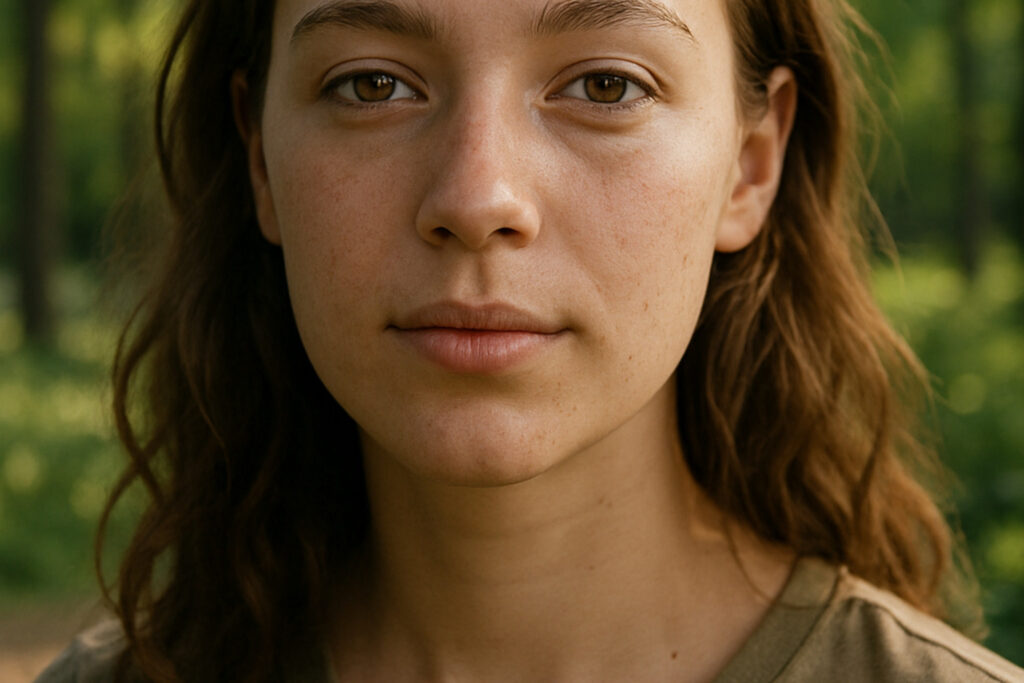Why Natural Beauty Photography Captures Hearts and Minds
Natural beauty photography focuses on capturing authentic, unretouched moments that showcase subjects in their most genuine state, often within natural environments. This photography style emphasizes:
- Minimal editing – preserving skin texture and natural features
- Environmental context – using outdoor settings and natural light
- Authentic emotions – capturing candid, unstaged expressions
- Sustainable approach – respecting nature and subjects equally
The appeal of natural beauty photography runs deeper than just aesthetics. As photographer Steve Biro puts it, experiencing natural beauty is “as close to a religious experience as it gets.” This genre taps into our innate connection with nature – what scientists call biophilia – while offering viewers a refreshing break from heavily filtered, artificial imagery.
Research shows that viewing nature imagery can reduce cortisol levels and boost concentration. When combined with authentic human portraits, natural beauty photography creates a powerful emotional pull that resonates across cultures and generations.
For eco-conscious creators like yourself, this photography style aligns perfectly with sustainable values. It celebrates natural features without excessive retouching, promotes outdoor wellness, and often incorporates environmental stewardship into the creative process.
The growing popularity is undeniable – platforms like Unsplash host over 14,000 photos tagged with ‘natural beauty’, while stock photo searches for nature consistently rank in the top 10 most popular categories.
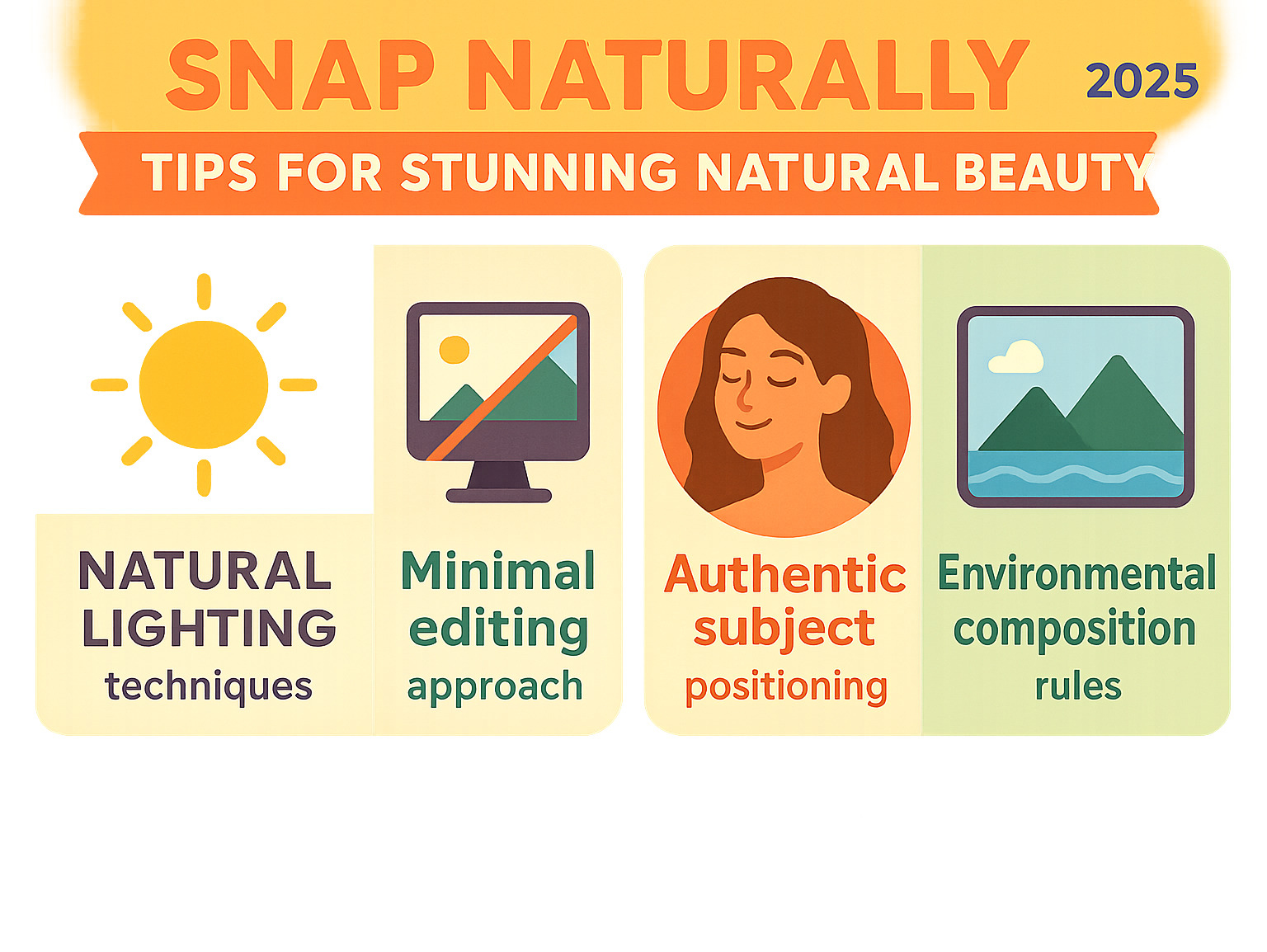
Natural beauty photography terms you need:
– fresh natural makeup look
– natural beauty confidence
– beauty tips for clear and glowing skin
Defining Natural Beauty Photography
Think of natural beauty photography as the gentle rebel of the photo world. Where studio shoots chase perfection through controlled lighting and heavy retouching, this genre celebrates the beautifully unpredictable.
| Studio Beauty Photography | Natural Beauty Photography |
|---|---|
| Controlled studio lighting | Natural light sources |
| Heavy retouching | Minimal editing, real texture |
| Perfect makeup & styling | Bare-faced or light makeup |
| Isolated backgrounds | Environmental context |
| Rigid posing | Candid moments |
Photographers who accept this approach spend more time outdoors, breathe fresher air, and feel less pressure—so do their subjects.
What Is Natural Beauty Photography?
At its core, natural beauty photography captures people as they are: real skin, real laughter, real stories. The setting—dew-covered grass, peeling barn wood, soft morning haze—doesn’t just decorate the frame, it advances the narrative.
Why Does It Resonate With Viewers?
The answer lies in our biophilia, the innate affinity humans have for nature. Studies show that even brief exposure to nature scenes lowers cortisol and sharpens focus, so pairing honest portraits with organic backdrops feels instantly comforting.
In a filter-heavy world, this authenticity feels radical. Viewers instinctively trust what hasn’t been over-polished, and that trust is the secret sauce that makes natural beauty photography so compelling.
Mastering Light & Composition for Natural Beauty
Think of natural light as your most patient teacher. Unlike studio strobes that fire the same way every time, natural light changes constantly – and that’s exactly what makes natural beauty photography so magical. Learning to read these shifts in light will transform your portraits from snapshots into soul-stirring images.
The golden hour remains photography’s most beloved time for good reason. Those precious moments just after sunrise and before sunset bathe everything in warm, honey-colored light that makes skin glow naturally. Your subjects will look like they’re lit from within, without any fancy equipment or post-processing tricks.
Backlighting during golden hour creates something almost ethereal. Position yourself so your subject stands between you and the setting sun, then watch as natural rim light outlines their hair and shoulders. It’s like nature’s own hair light, but softer and more forgiving than any studio setup.
Don’t pack up your camera when clouds roll in. Overcast conditions work like the world’s largest softbox, wrapping your subject in even, flattering light. This diffused lighting eliminates harsh shadows and creates that coveted soft glow that expensive studio modifiers try to replicate.
Natural Light Techniques for Skin Glow
The secret to achieving radiant skin in your photos lies in understanding how to work with the light you’re given. Reflectors become your best friend here – and they don’t have to be expensive. A simple white poster board or even fresh snow can bounce beautiful, soft light onto your subject’s face.
Rim lighting happens naturally when you position your subject with light coming from behind them. This technique separates them from the background and creates that luminous outline that makes people look almost angelic. The trick is finding just the right angle where the light kisses the skin without creating unflattering shadows.
Diffused shade offers some of the most flattering light you’ll ever find. Position your subject just at the edge of shade – maybe under a tree’s canopy or beside a building. They’ll receive soft, indirect light that eliminates harsh shadows while keeping enough brightness for a perfect exposure.
For subjects who want to improve their natural radiance beyond what lighting can achieve, our guide on Natural Skincare Tips offers wonderful ways to achieve that healthy glow from within.
Compositional Secrets That Spotlight Natural Features
Negative space works like a breath of fresh air in your compositions. By giving your subject plenty of room to breathe within the frame, you let their natural beauty take center stage. This approach also strengthens the connection between your subject and their natural environment.
Foreground framing uses nature’s own elements to create depth and guide the viewer’s eye. Think branches, tall grass, or wildflowers that naturally frame your subject. This technique adds layers to your image while keeping everything feeling organic and unforced.
Macro focus on intimate details tells powerful stories about natural beauty. A close-up of eyes reflecting golden light, hands gently touching tree bark, or the way sunlight dances across skin creates emotional connections that wide shots sometimes miss.
Look for rhythm and patterns in nature – repeating tree trunks, gentle wave patterns, or clusters of flowers. These natural elements create leading lines that draw attention to your subject while adding visual interest to the composition.
Natural Beauty Photography and the Golden Hour
The golden hour deserves its own spotlight in natural beauty photography because it naturally improves everything we’re trying to achieve. That warm, soft light minimizes skin imperfections while creating natural contouring that would take complex studio lighting to replicate.
Long shadows during this magical time add drama and depth to your compositions. Use these shadows creatively – let them partially frame your subject or create interesting patterns across their face. The interplay of light and shadow tells stories that flat lighting simply can’t.
There’s science behind why golden hour portraits feel so emotionally compelling. Warm light triggers positive responses in both your subjects and viewers, making your images more engaging and memorable. Your subjects will feel more relaxed, and that comfort shows in their expressions.
The soft tones of golden hour naturally complement all skin tones, eliminating the need for complex color correction later. This means more time creating and less time fixing – exactly what natural beauty photography is all about.
Shooting People & Places: Practical Field Guide
Taking your camera into nature transforms you from a photographer into an environmental storyteller. Natural beauty photography in the field requires a completely different approach than studio work – you’re collaborating with Mother Nature herself, and she doesn’t always cooperate on schedule.
The magic happens when you stop fighting the environment and start dancing with it. That unexpected gust of wind that tousles your model’s hair? That’s not a problem – it’s poetry in motion. The cloud that just covered your perfect golden hour light? It might create the most beautifully diffused portrait lighting you’ve ever seen.
When you’re working with models in natural settings, you’re creating a three-way conversation between subject, environment, and camera. The landscape isn’t just a pretty backdrop – it’s an active participant that can improve or complement your subject’s natural beauty.
Candid lifestyle moments often produce the most compelling images. There’s something magical about capturing someone lost in thought while sitting by a stream, or the genuine laugh that erupts when they feel raindrops on their skin. These unguarded moments reveal authentic beauty that no amount of posing can replicate.
Wildlife and landscape photography demand their own special considerations. Ethical distance from animals isn’t just about safety – it’s about respecting their natural behavior and habitat. The leave-no-trace principle applies to every shot you take, ensuring these beautiful spaces remain pristine for future generations.
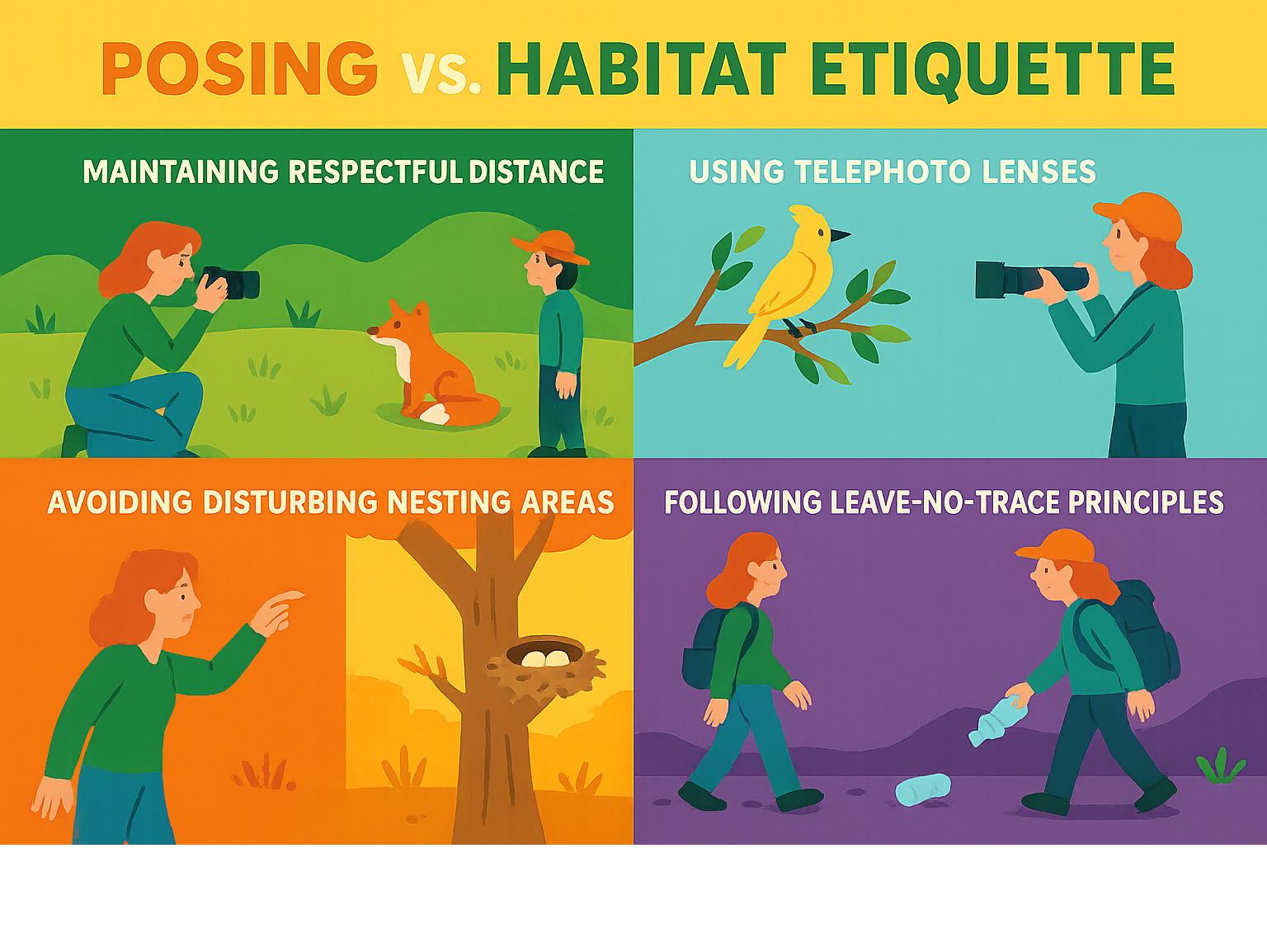
Photographing People to Highlight Their Natural Beauty
The secret to capturing authentic natural beauty lies in creating connection, not perfection. Instead of barking directions like a drill sergeant, try gentle prompts that help your subject connect with their environment. “Feel that warm sunlight on your face” works so much better than “tilt your head exactly 15 degrees to the left.”
Wardrobe in neutral tones becomes your best friend in natural settings. Think soft creams, earthy browns, muted greens, and gentle grays. These colors harmonize with natural environments rather than screaming for attention. Your subject’s natural beauty should be the star, not their neon pink jacket.
The most powerful tool in your kit? Patience. Give your subject time to settle into the space and breathe. Let them explore the environment, touch the bark of that old oak tree, or feel the grass beneath their feet. Genuine emotion emerges when people feel connected to their surroundings, not when they’re worried about holding a pose.
For those looking to improve their natural features for photo sessions, our guide on Natural Makeup offers techniques that complement rather than mask your inherent beauty.
Natural beauty photography celebrates authenticity over perfection. Those little imperfections – the flyaway hair, the natural skin texture, the genuine smile lines – these are what make images relatable and beautiful.
Capturing Authentic Landscapes, Plants & Wildlife
Mother Nature doesn’t wait for anyone, so your technical skills need to be second nature. A sturdy tripod becomes essential when you’re dealing with changing light conditions and longer exposures. Wind, uneven terrain, and the need for sharp detail in landscapes make camera stability non-negotiable.
ND filters open up creative possibilities that would be impossible otherwise. Want to capture that dreamy, silky water movement in broad daylight? ND filters let you use slower shutter speeds even when the sun is blazing. They’re particularly magical for capturing cloud movement that adds life to static landscape scenes.
Here’s the hard truth about natural beauty photography: patience beats equipment every single time. That perfect moment when the light hits just right, when the deer finally steps into your frame, when the wind stops long enough for a sharp macro shot – these moments can’t be rushed or forced.
Seasonal palettes offer completely different emotional stories throughout the year. Spring brings fresh hope with its tender greens and delicate pastels. Summer explodes with rich, saturated colors that practically vibrate with life. Autumn wraps everything in warm, golden tones that make every portrait feel like a cozy hug. Winter strips everything down to stark, honest beauty that can be breathtakingly powerful.
The rule of thirds works beautifully in natural settings, but don’t become a slave to it. Sometimes centering your subject creates more impact, especially when they’re surrounded by symmetrical natural elements like a grove of trees or a mountain reflection in still water.
Most importantly, approach every natural environment with respect and humility. We’re guests in these spaces, and our responsibility extends far beyond getting the perfect shot.
Gear & Editing for Authentic Results
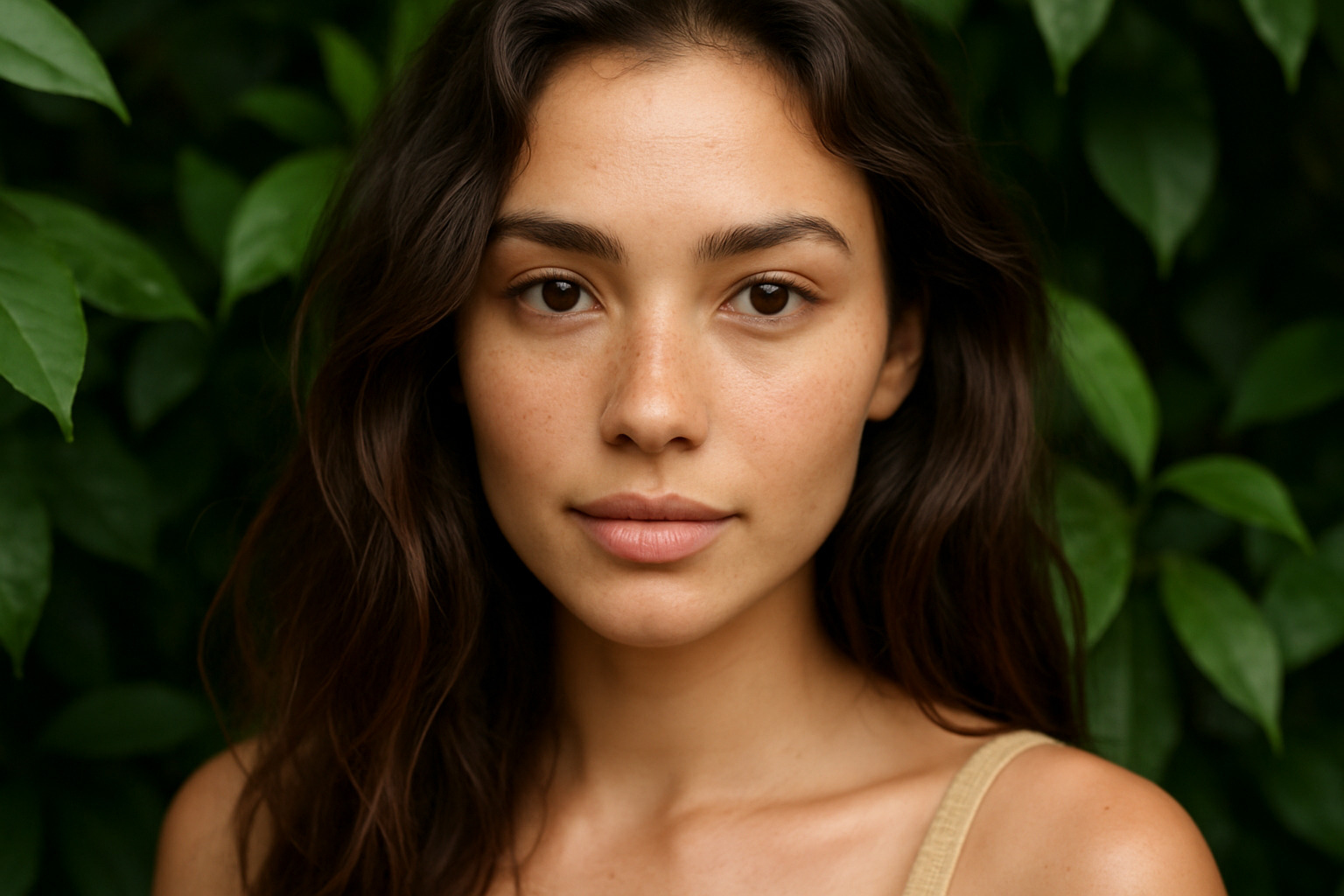
The beauty of natural beauty photography lies in its simplicity – you don’t need a studio full of expensive equipment to create stunning images. However, choosing the right tools can make the difference between good photos and breathtaking ones that truly capture authentic natural beauty.
Mirrorless camera bodies have become the go-to choice for field photographers. They’re significantly lighter than traditional DSLRs, which matters when you’re hiking to that perfect meadow location. The electronic viewfinders help you compose shots even in bright sunlight, and the built-in image stabilization means you can shoot handheld in lower light conditions.
When it comes to lenses, prime lenses between 35mm and 135mm offer the perfect range for natural beauty work. An 85mm lens creates beautifully flattering portraits with natural perspective, while a 35mm captures environmental portraits that tell a fuller story.
Macro lenses open up an entirely different world of natural beauty photography. Imagine capturing the delicate texture of someone’s eyelashes catching morning dew, or the intricate patterns of flower petals that complement your subject’s features.
Don’t overlook the power of circular polarizing filters. They cut through reflections on water and wet surfaces while boosting color saturation naturally. When you’re photographing someone near a lake or after rain, a CPL filter can transform an ordinary scene into something magical.
ND filters give you creative control over time and motion. They allow you to use slower shutter speeds even in bright daylight, creating silky water movement or soft cloud motion that adds dynamic energy to your natural beauty shots.
Recommended Equipment & Camera Settings
Understanding your camera settings makes all the difference in achieving that natural, authentic look. Aperture settings between f/2.8 and f/11 cover most situations you’ll encounter. Wide apertures like f/2.8 create that dreamy background blur that makes your subject pop from their natural surroundings, while f/8 to f/11 keeps everything sharp when you want to show the full environmental context.
Base ISO settings (usually 100-400 on most cameras) give you the cleanest image quality and maximum flexibility when editing. Modern cameras handle higher ISOs beautifully, but starting low means you can always push the exposure in post-processing without introducing unwanted noise.
Shutter speed depends on your subject and creative intent. For handheld portraits, stick to at least 1/focal length to avoid camera shake. When photographing children or wildlife, faster speeds freeze those spontaneous moments that make natural beauty photography so compelling.
Budget shouldn’t stop you from creating beautiful natural beauty photography. White poster board or car windshield shades work brilliantly as reflectors. Extension tubes give you macro capabilities without the cost of dedicated macro lenses. Your smartphone can often control your camera remotely.
Post-Processing Without Losing the Natural Feel
The editing phase is where many natural beauty photographs lose their authenticity – but it doesn’t have to be that way. RAW file format gives you incredible flexibility while maintaining that natural feel. Unlike JPEGs, RAW files preserve all the image data, letting you make significant improvements without that over-processed look.
White balance correction ensures your subject’s skin tones look natural and healthy. Natural light changes color temperature throughout the day, and proper white balance maintains the authentic mood of the original moment. Research on color perception shows that natural color palettes promote positive emotional responses – exactly what we want in natural beauty photography.
Gentle contrast adjustments can make your images sing without screaming “edited!” A subtle increase in contrast adds depth and dimension while preserving the soft, natural quality that defines this genre.
Spot removal tools handle minor distractions or temporary blemishes, but here’s where restraint becomes crucial. Preserve natural skin texture and authentic features. The goal is to present your subject’s best natural self, not create an artificial version of them.
Popular editing software like Lightroom and mobile apps like Snapseed offer powerful tools for subtle improvements. The key is knowing when to stop – your edits should feel invisible to viewers.
For those interested in enhancing natural beauty beyond photography techniques, our guide on Natural Beauty Remedies offers holistic approaches to achieving that healthy, natural glow from within.
Challenges, Ethics & FAQs
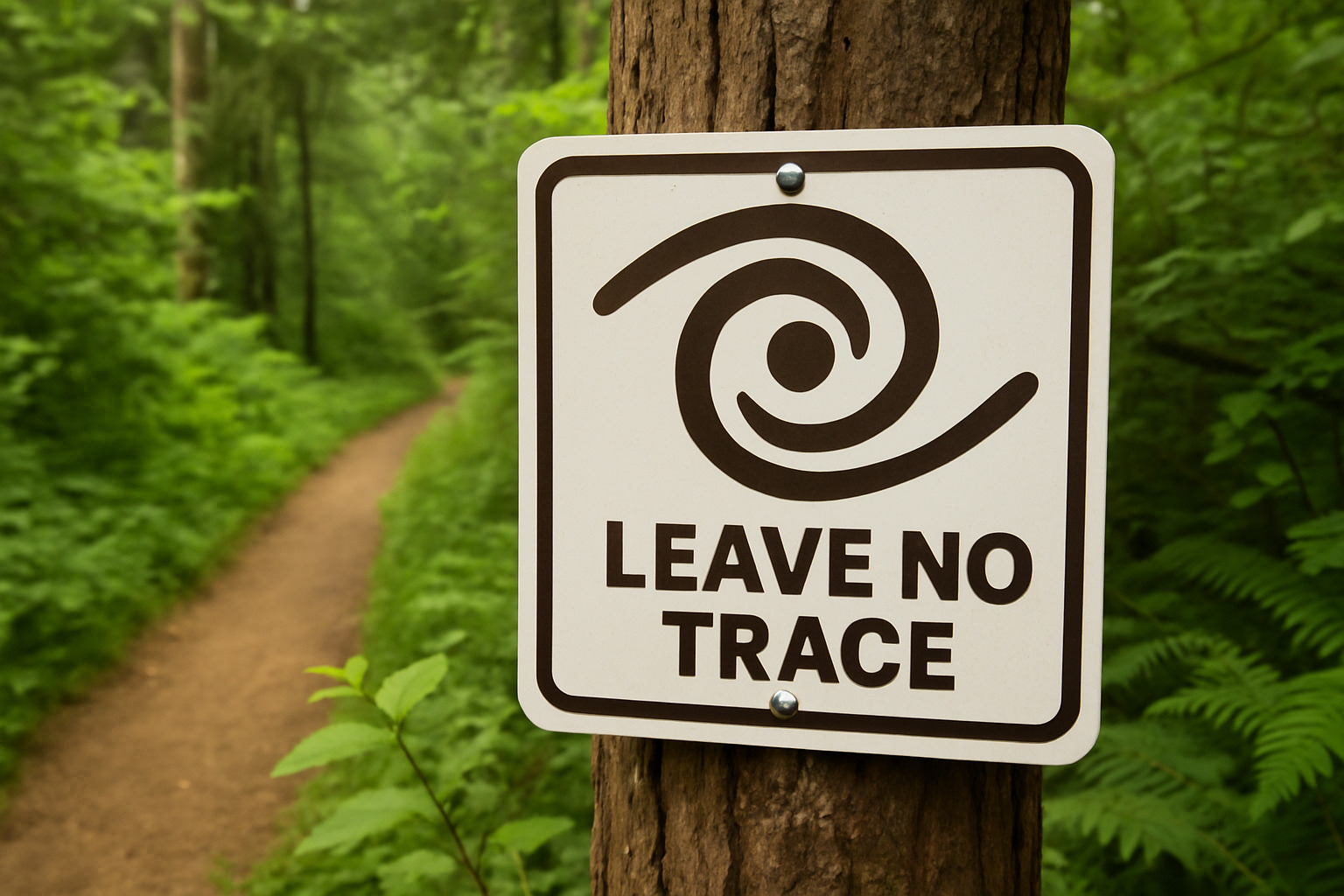
Let’s be honest – natural beauty photography isn’t always as peaceful as the final images suggest. Mother Nature doesn’t always cooperate, and ethical considerations add layers of complexity that studio photographers never face.
The harsh noon sun turns into your biggest nemesis, creating unflattering raccoon eyes and making your subjects squint like they’re solving complex math problems. Weather can shift from perfect golden hour light to torrential downpour in minutes. And don’t get me started on trying to photograph that perfect butterfly that keeps flying away just as you nail the focus.
But here’s the thing – these challenges often lead to the most rewarding shots. That unexpected storm might create dramatic lighting you never could have planned. The “terrible” midday sun might cast interesting shadows that add character to your portrait.
Moving wildlife requires the patience of a meditation master and the quick reflexes of a sports photographer. You’ll spend hours waiting for that deer to look your way, only to have it bound away the moment you raise your camera.
Privacy becomes tricky when you’re shooting in popular natural spaces. That perfect waterfall backdrop might be someone else’s peaceful retreat, and suddenly you’re navigating social dynamics along with technical challenges.
Overcoming Common Field Obstacles
Weather apps become your crystal ball, though nature loves to prove forecasters wrong. Check multiple sources and always expect the unexpected. I’ve learned to pack for three different weather scenarios on every shoot.
Lens hoods protect against more than just rain – they’re your shield against harsh side lighting, unexpected snowflakes, and curious insects. Think of them as your lens’s personal bodyguard.
Smart photographers always have backup plans. Scout multiple locations beforehand, know where the nearest covered areas are, and keep your schedule flexible. Sometimes Plan B turns out better than Plan A anyway.
Protective gear isn’t just about expensive camera rain covers. A simple plastic bag can save your equipment, and wearing appropriate clothing means you can focus on photography instead of being miserable. Comfortable photographers take better pictures.
Ethical Guidelines for Shooting Nature & People
Model releases protect everyone involved, even for casual shoots with friends. Clear communication about how images will be used prevents awkward conversations later and ensures everyone feels respected throughout the process.
Wildlife photography demands serious respect for animal welfare. If your presence changes an animal’s behavior, you’re too close – period. Use longer lenses and practice patience. The shot is never worth causing stress to wildlife.
Leave No Trace principles aren’t just suggestions – they’re essential for preserving the natural spaces we love to photograph. Pack out every piece of trash, stay on designated trails, and resist the urge to move plants or rocks for better compositions.
Model consent goes deeper than legal paperwork. Check in regularly about comfort levels, respect boundaries, and remember that natural beauty photography should empower your subjects, never make them feel vulnerable or exploited.
Frequently Asked Questions
How do you handle harsh midday lighting?
Accept the shade! Open shade under trees or building overhangs provides beautiful, even lighting. Use reflectors to bounce soft light onto faces, or get creative with the dramatic shadows – sometimes “bad” light creates the most interesting artistic effects.
Can you shoot compelling natural beauty photography with just one lens?
Absolutely! A 50mm or 85mm prime lens handles most natural beauty situations beautifully. Working with limitations often sparks more creativity than having endless options. You’ll learn to move your feet instead of reaching for different lenses.
How much editing crosses the line in natural beauty photography?
If your edit makes the image look dramatically different from what you actually captured, you’ve gone too far. The goal is improvement, not change. When in doubt, dial back those adjustments and trust the natural beauty you captured in-camera.
What’s the best way to direct non-professional models?
Skip the technical jargon and use descriptive, gentle prompts. Instead of “rotate your chin 15 degrees counterclockwise,” try “turn toward that warm sunlight” or “close your eyes and listen to the birds.” Natural direction leads to natural expressions.
Conclusion
There’s something magical about natural beauty photography that speaks to our souls in ways heavily filtered images never can. It’s the difference between a genuine smile and a forced one – you just know authenticity when you see it.
Throughout this journey, we’ve explored how natural light becomes your best friend, how patience pays off in the field, and why respecting both your subjects and the environment creates better photographs. But beyond the technical aspects, natural beauty photography offers something deeper – a chance to slow down and truly see the beauty that surrounds us every day.
At Beyond Beauty Lab, we’re passionate about celebrating authentic beauty in all its forms. This photography style perfectly captures what we believe – that real beauty emerges when we honor our natural selves and the world that nurtures us. There’s no need for heavy retouching or artificial improvement when you’re working with genuine moments and natural light.
The techniques we’ve covered aren’t just about taking better pictures. They’re about developing a mindful approach to creativity that benefits everyone involved. When you spend time outdoors with your camera, you’re practicing a form of moving meditation. When you help someone see their natural beauty through your lens, you’re offering a gift that goes far beyond photography.
Your camera equipment matters, but your ability to connect with people and environments matters more. The most expensive lens won’t capture authentic emotion if you’re not genuinely present with your subject. The fanciest editing software can’t add soul to an image that lacks it from the start.
As you continue practicing natural beauty photography, every sunrise offers new light to explore. Every person you photograph has their own unique beauty story. Every natural setting provides fresh opportunities to grow as both a photographer and a human being.
For those ready to accept their authentic selves both behind and in front of the camera, we invite you to explore our guide on finding your natural beauty confidence. True confidence – like great photography – starts with accepting and celebrating what’s already naturally beautiful about you.
The growing love for natural beauty photography reflects something important happening in our world. People are craving authenticity over perfection, connection over isolation, and sustainability over waste. By mastering these gentle techniques and ethical practices, you’re joining a movement that values genuine beauty and environmental responsibility.
Your photography journey doesn’t end here – it’s just beginning. Every time you choose natural light over harsh flash, every moment you wait patiently for the perfect expression, every decision to preserve rather than over-edit, you’re contributing to a more authentic and beautiful world.

